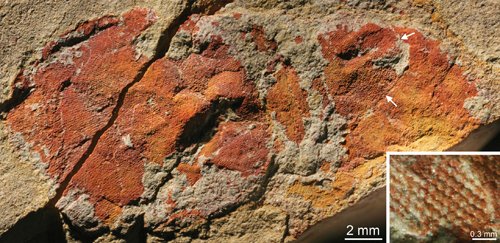Fossilised eyes of ancient super-predator found

AUSTRALIAN SCIENTISTS ARE hailing the discovery of a pair of insect-like eyes belonging to a freakish, prehistoric super-predator which trawled the seas more than 500 million years ago.
Measuring 3cm across and with a whopping 16,000 individual lenses, the fossilised eyes were found in rocks on South Australia’s Kangaroo Island. They are from a huge shellfish-type creature called Anomalocaris.
Anomalocaris could grow up to one metre long and were considered the “great white shark” of the Cambrian era, topping the ancient marine food chain, according to lead researcher Dr John Paterson at the University of New England in Armidale.
Modern-day houseflies have about 3000 lenses in their eyes, while dragonflies have about 30,000 – the only creatures known to have more lenses than Anomalocaris.
“Alien-looking beast”
Paterson said the discovery showed that Anomalocaris had lived in well-lit, clear waters and had developed sophisticated vision extremely rapidly, likely triggering an evolutionary “arms race” among other creatures.
Spines, poison glands and other defence mechanisms had probably erupted among creatures eager to escape detection by its huge eyes, which protruded from the side of its head on stalks. “When you look at the animal itself it’s quite an alien-looking beast,” says John.
The fact that Anomalocaris had been found to have compound eyes also confirmed it was an ancestor of modern arthopods, which include insects and shellfish, according the the report which is published this week in the journal Nature.
When the specimen was originally trapped in seafloor mud about 500 million years ago, Australia, then part of the supercontinent of Gondwana and sat in tropical waters straddling the equator.

The stalked eyes of Anomalocaris from South Australia, with arrows pointing to the boundary between the stalk and visual surface, plus the intricate lenses preserved (inset). (Credit: John Patterson)
Slowly pushed
The fossil had been slowly pushed from the sea floor at about the same speed that human fingernails grow, and eventually ended up on Kangaroo Island – now a hotbed of Cambrian-era artefacts – off the coast of Adelaide in South Australia.
Though specimens had been found before in Canada and China, the Australian deposit was the first place an intact eye had been discovered, due to the unique shale rock it was trapped in, which had once been “zero-oxygen” mud.
“Within the mud or within the sediment there’s essentially no oxygen to allow for microbes to start to break down soft tissues,” John says. “What we’ve seen in the Emu Bay shale at Kangaroo Island is a much better picture of what was living there at the time than you would otherwise get in a conventional fossil deposit.”
RELATED STORIES




